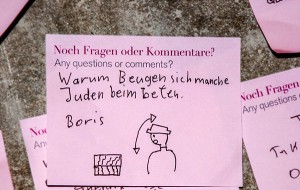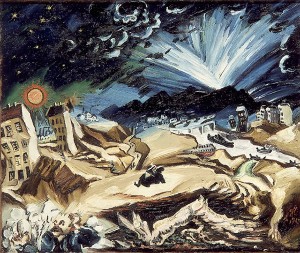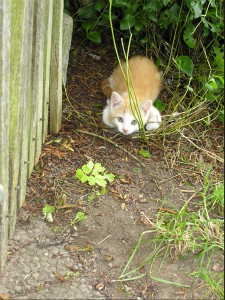“Why do some Jews rock back and forth while they pray?”
Our special exhibition “The Whole Truth… everything you always wanted to know about Jews” is based on 30 questions posed to the Jewish Museum Berlin or its staff over the past few years. In the exhibition, visitors have their own opportunity to ask questions or to leave comments on post-it notes. Some of these questions will be answered here in our blog, such as last month’s query: “how does a kippah stay on?” This month, we respond to Boris, who wants to know “why some Jews rock back and forth while they pray?”

“Why do some Jews rock back and forth while they pray? Boris”
© photo: Thomas Valentin Harb, Jewish Museum Berlin
Dear Boris,
Many people have asked why religious Jews sway back and forth while praying. This very old custom is called shuckling in Yiddish and means to rock, shake, or swing. As with many customs, it is easier to describe when and where it was practiced, than to answer definitively, why people shuckle while praying and studying the Torah. → continue reading
Everyday Absurdities at the Museum
Sometimes even a museum’s normal workday provides surprises. About a week ago I found in my postbox a letter from the provincial capital of Stuttgart, specifically, from its office for public order.
Information about fines and tickets occasionally lands on my desk, since I am in charge of a team that travels around Germany in our museum bus doing mobile educational work at schools. In the struggle against ignorance and anti-Semitism, speed is of the essence. So I flipped through to the second page to ascertain how much we owed this time: € 104,80. For animal custody and veterinary services?! This is no normal parking ticket.
I turned back to the first page and read the letter from top to bottom: “Saving Ms. K’s cat.” Did my colleagues run over a cat, or did they find one and take it to the animal shelter? → continue reading
A cold wind blows tiles off of roofs and hats off of heads. The first pages of Robert Schindel’s new novel Der Kalte (The Cold One), read here by the author, are stormy. The Austrian novelist, poet and essayist born in 1944 already won over his readers with his persuasive images and poetic language in Gebürtig (Born-Where), published in 1992. Here too, the atmospheric beginning is reminiscent of the first line of the expressionist poem “Weltende” (End of the World): “From bourgeois’ pointed heads their bowlers flew, the whole atmosphere’s like full of cry” (Jakob van Hoddis).

Apocalyptic Landscape by Ludwig Meidner, 1913
© Ludwig Meidner-Archive, Jewish Museum Frankfurt-am-Main
Yet in the first scene of Schindel’s novel a world unfolds: Vienna of the Waldheim affair, from 1985 to 1989. During the 1986 Austrian election campaign, a debate ignited around the conservative candidate, Kurt Waldheim, who was indicted for war crimes. In his autobiography, he had concealed his time as a Wehrmacht-officer. Represented in the novel by the figure Johann Wais, he professes “that he had done nothing that one hundred thousand other Austrians had not done, too.” This is precisely why he functions “as an involuntary clarifying machine.” → continue reading



